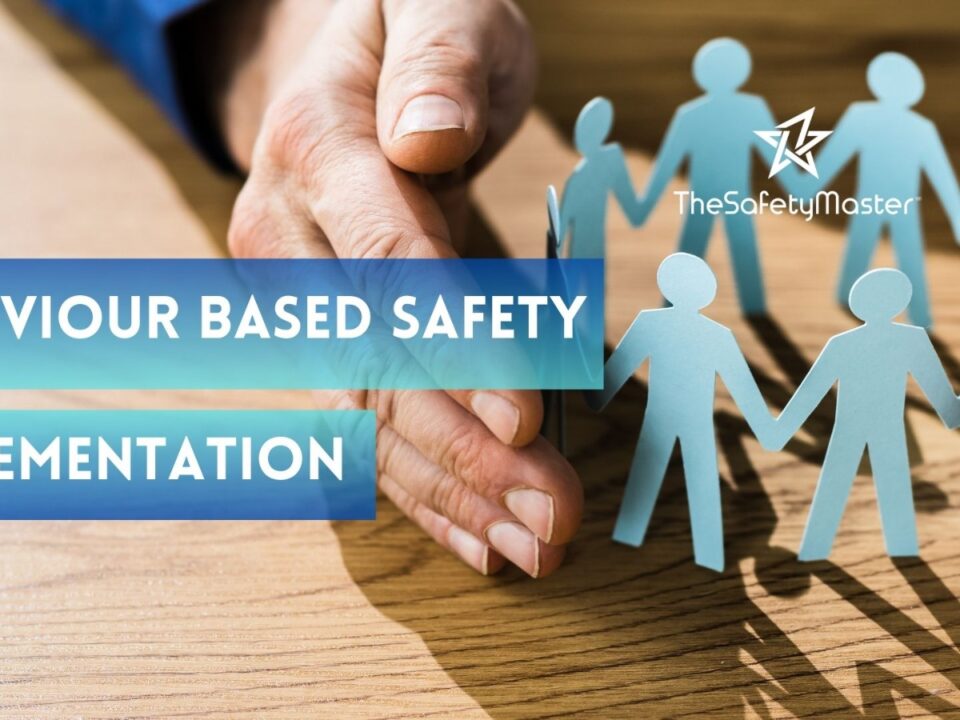Unleashing the Potential: How Behaviour Based Safety Implementation Transforms Employee Mind-sets

The Importance of HAZOP Study in Preventing Accidents and Promoting Safe Operations in Indian Chemical Plants
October 30, 2023
Understanding the Benefits of Ergonomics Assessments for Better Employee Health and Performance in Indian Industries
November 1, 2023In this article, we delve into the transformative power of Behaviour Based Safety Implementation, uncovering its ability to unleash the true potential within every employee’s mind set. By highlighting the crucial problem that often plagues workplaces – complacency and disengagement – we shed light on the game-changing solution that lies in behavioural shifts. Discover how this methodology empowers organizations to cultivate a culture of proactive safety, enhanced productivity, and lasting employee growth. Brace yourself for insights that will revolutionize the way you perceive workplace safety, while promising a path towards unlocking untapped potential and elevating overall performance. So, let’s embark on this enlightening journey together!
Introduction
Unleashing the Potential: How Behaviour Based Safety Implementation Transforms Employee Mind-sets. In today’s fast-paced and demanding work environments, ensuring the safety and well-being of employees is of paramount importance. However, traditional safety practices often fall short in truly transforming employee mind-sets towards a proactive approach to safety. This is where Behaviour Based Safety (BBS) implementation comes into play, revolutionizing the way organizations approach workplace safety.
Throughout this enlightening article, we will delve into the depths of BBS implementation and explore how it has the power to unleash the untapped potential within employees. By fostering a culture that values behavioural observations, enhancing safety awareness, implementing effective training programs, and providing continuous feedback and reinforcement, organizations can create a positive safety culture that not only safeguards their employees but also boosts productivity and morale
Understanding Behaviour Based Safety Implementation
Understanding Behaviour Based Safety Implementation: Behaviour Based Safety (BBS) is a proactive approach to mitigate workplace accidents and injuries by focusing on the role of human behaviour. It acknowledges that employee actions and attitudes significantly influence safety outcomes within an organization. BBS aims to transform employee mind-sets by cultivating a safety-conscious culture where individuals take responsibility for their own actions and actively contribute to maintaining a hazard-free environment.
At its core, BBS goes beyond traditional safety protocols by recognizing that accidents are not merely random incidents but rather predictable patterns resulting from behavioural choices. By understanding the psychological factors that drive employee behaviour, organizations can implement targeted interventions that address root causes and promote safer practices. This approach is rooted in the belief that every individual has the potential to make a positive impact on workplace safety.
Incorporating BBS requires organizational commitment to not only identify unsafe behaviours but also understand the underlying motivations driving them. By recognizing that employees’ actions are influenced by factors such as training deficiencies, inadequate supervision, or even personal stressors, organizations can tailor solutions that address these challenges effectively. This holistic understanding empowers leaders to foster an environment where employees feel valued, supported, and encouraged to prioritize safety above all else. Rather than assigning blame or punishment for lapses in safety procedures, BBS encourages open dialogue and constructive feedback for continuous improvement.
By embracing Behaviour Based Safety implementation, organizations cultivate a sense of collective responsibility for safety among employees at all levels — from top management to frontline workers. This shift in mind set instils confidence in team members as they become active participants in identifying hazards, correcting unsafe behaviours, and championing best practices across the organization
The Importance of Employee Mind-sets in the Workplace
The Importance of Employee Mind-sets in the Workplace: In the intricate tapestry of organizational dynamics, employee mind-sets play a pivotal role, acting as the driving force behind workplace behaviour and performance. It is an undeniable truth that a positive mind set can catalyse productivity, foster innovation, and strengthen team cohesion. Conversely, negative mind-sets can create a toxic work environment marred by inefficiency and disengagement.
When employees adopt a growth-oriented mind set, they embrace challenges as opportunities for learning and development. They approach their work with resilience and determination, striving for excellence even in the face of adversity. This mind set nurtures a culture of continuous improvement, where individuals are motivated to expand their skills and knowledge while actively seeking innovative solutions.
Moreover, an optimistic mind set can ignite creativity within teams, fuelling collaboration and enabling them to tackle complex problems with enthusiasm. It fosters open communication channels where ideas flow freely without fear or judgment. By embracing a positive outlook on their abilities and the potential for success, employees become more willing to take calculated risks that could lead to breakthroughs or new avenues for growth.
Ultimately, cultivating employee mind-sets aligned with organizational goals creates a virtuous cycle of positivity within the workplace. When individuals believe in their own capabilities and see value in their contributions towards shared objectives, morale rises exponentially. This sense of purpose increases job satisfaction levels while inspiring employees to go above and beyond to achieve remarkable results.
By recognizing the significance of employee mind-sets within the workplace ecosystem, organizations hold the key to unlocking untapped potential in their workforce. Empowering individuals with an optimistic perspective not only enhances individual performance but also fuels collective success through increased engagement and collaborative creativity
Unleashing the Potential: A Closer Look at Behaviour Based Safety
Unleashing the Potential: A Closer Look at Behaviour Based Safety Behaviour Based Safety (BBS) is a powerful approach that holds the key to transforming employee mind-sets and fostering a culture of safety within organizations. By focusing on human behaviour, BBS aims to identify and modify unsafe actions, while reinforcing positive behaviours that contribute to a safer work environment. This method goes beyond traditional safety programs by actively involving employees in the process, empowering them to become safety advocates.
At its core, BBS recognizes that every action performed by individuals in the workplace has an impact on safety outcomes. By understanding human behaviour patterns and motivations, organizations can design interventions that encourage safe practices and minimize risks. Through careful observation and analysis, BBS uncovers the underlying causes of unsafe behaviour, whether they stem from inadequate training, lack of awareness, or external factors like time pressure.
By implementing BBS strategies effectively, organizations can unlock their true potential for safety excellence. Instead of relying solely on rules and regulations to enforce compliance, BBS encourages proactive engagement from employees at all levels. This shift towards collective responsibility fosters a sense of ownership over safety within each individual. Furthermore, as employees witness positive changes in their own behaviour leading to safer outcomes, job satisfaction increases along with morale among teams.
The true strength of Behaviour Based Safety lies not only in its ability to mitigate risks but also in its capacity for cultural transformation within organizations. By promoting open communication channels and providing continuous feedback loops between workers and management, BBS fosters an environment where every individual feels valued and empowered in contributing to overall workplace safety. This inclusive approach creates a positive ripple effect throughout the organization – one that transcends traditional measures – ultimately leading to improved productivity and increased employee well-being
Key Elements of Behaviour Based Safety Implementation
Key Elements of Behaviour Based Safety Implementation: In order to successfully implement behaviour-based safety (BBS) in the workplace, several key elements must be considered. First and foremost, there needs to be strong leadership commitment and support. This involves top management actively endorsing and participating in the BBS program, setting a positive example for all employees. Leaders should communicate their belief in the importance of safety and encourage a culture where employees feel comfortable reporting unsafe behaviours or conditions.
Another crucial element is the establishment of clear expectations and goals. Employees need to understand what is expected of them in terms of safety performance and behaviour. This can be achieved through comprehensive training programs that educate staff on the principles of BBS, potential hazards in their specific work environment, and how to effectively observe and report behaviours.
Moreover, providing regular feedback and reinforcement is essential for sustaining behaviour change. When employees receive constructive feedback on their actions, both positive reinforcement for safe behaviour and corrective measures for unsafe practices, they are more likely to internalize these observations and make necessary adjustments. Recognizing individuals or teams who consistently demonstrate safe behaviours can further foster a positive safety culture.
By incorporating these key elements into an organization’s BBS implementation strategy, employers can create an environment that not only reduces accidents but also transforms employee mind-sets towards prioritizing safety as an integral part of daily operations. With leaders leading by example, clear expectations set forth, ongoing training programs provided, and continuous feedback given, employees will feel empowered to make safe decisions while embracing a collective responsibility for maintaining a secure workplace.
Behavioural Observations: Enhancing Safety Awareness
In the realm of workplace safety, behavioural observations serve as powerful tools for enhancing safety awareness among employees. These observations involve systematically monitoring and recognizing safe and at-risk behaviours exhibited by individuals in the workplace. By focusing on positive behaviours and providing constructive feedback, organizations can foster a culture of vigilance and accountability. Through behavioural observations, employees become more attuned to their own actions and those of their colleagues. They develop a heightened sense of awareness, allowing them to identify potential hazards and make conscious choices to mitigate risks. This increased vigilance not only improves personal safety but also creates a ripple effect throughout the organization, inspiring others to adopt safer practices.
By implementing robust systems for conducting behavioural observations, companies empower employees to take ownership of their own safety and that of their peers. This process encourages open communication channels where individuals feel comfortable reporting near misses or unsafe conditions promptly. Ultimately, this proactive approach not only prevents accidents but also nurtures a flourishing safety culture where every employee becomes an active participant in maintaining a secure work environment.
Training Programs: Shaping Employee Behaviour
Training Programs: Shaping Employee Behaviour Training programs play a pivotal role in shaping employee behaviour and fostering a culture of safety within organizations. By equipping employees with the necessary knowledge and skills, these programs empower individuals to make safe choices in their daily tasks. A comprehensive training program should cover a wide range of topics, including hazard identification, risk assessment, proper use of personal protective equipment (PPE), emergency response protocols, and effective communication.
One creative approach to training is the use of interactive workshops and simulations. These engaging sessions allow employees to actively participate in safety scenarios, immersing themselves in realistic situations where they must make decisions that prioritize their well-being and that of their colleagues. By simulating potential workplace incidents, these programs create a safe space for employees to learn from mistakes without real-world consequences.
Moreover, training programs can incorporate gamification techniques to make learning enjoyable and increase engagement. By introducing elements such as rewards, leaderboards, and achievements, employees are motivated to actively participate in the training process. This not only boosts knowledge retention but also fosters healthy competition among colleagues, encouraging them to continuously improve their safety practices.
Remember: Training is not just about imparting information; it is about inspiring individuals to embrace safety as a core value. When conducted effectively, training programs have the power to transform employee mind-sets by instilling a sense of responsibility for one’s own well-being as well as the well-being of others. This shift in perspective creates an optimistic ripple effect throughout an organization where everyone contributes to creating a safer work environment – one that promotes growth and success for all involved.
Feedback and Reinforcements: Building a Positive Safety Culture
Feedback and Reinforcements: Building a Positive Safety Culture in the realm of behaviour-based safety implementation, feedback and reinforcements play a pivotal role in cultivating a positive safety culture within organizations. By providing regular feedback on employee behaviours, both positive and corrective, employers can demonstrate their commitment to ensuring a safe work environment. This not only boosts employee morale but also encourages a sense of accountability and ownership towards safety.
Feedback sessions serve as opportunities for open dialogue between supervisors and employees, fostering trust and collaboration. Constructive feedback empowers individuals to recognize their strengths while offering insights on areas that require improvement. Implementing a reward system further reinforces safe behaviours, creating an atmosphere where employees feel valued for their contributions to workplace safety.
By leveraging the power of positive reinforcement, organizations can tap into the innate human desire for recognition. Recognizing individuals who consistently adhere to safety protocols not only motivates them but also serves as inspiration for others to follow suit. This collective effort gradually transforms the workplace into a haven where everyone actively contributes towards building a strong safety culture.
Remember, building a positive safety culture is an ongoing journey that requires consistent efforts from all levels of the organization. By embracing feedback and implementing effective reinforcement strategies, organizations can foster an environment where every employee feels invested in their own well-being as well as that of their colleagues—an essential foundation for unleashing the potential within each individual and propelling overall organizational success.
Overcoming Challenges in Implementing Behaviour Based Safety
Overcoming Challenges in Implementing Behaviour Based Safety The path to successful Behaviour Based Safety (BBS) implementation is not without its obstacles. However, with determination and a well-structured approach, these challenges can be overcome, paving the way for a transformative shift in employee mind-sets toward safety.
One common challenge is resistance to change. Employees may fear that BBS implementation will add additional workload or disrupt established routines. To address this, it is crucial to communicate the benefits of BBS clearly and involve employees in the process from the beginning. Emphasize how BBS empowers them by providing a safer work environment and fostering personal growth.
Another obstacle lies in shifting organizational culture. Sometimes, deep-rooted beliefs and practices hinder the adoption of new safety measures. A thoughtful strategy for cultural change must be devised, focusing on education, open communication, and leadership buy-in. Encourage leaders to lead by example, showcasing their commitment to safety through active participation in behavioural observations and consistently reinforcing safe behaviours.
Lastly, adequate resources are key for successful BBS implementation. Lack of funding or insufficient support can impede progress. By highlighting cost savings associated with reduced incidents and improved productivity, organizations can garner support from stakeholders and secure necessary resources.
By addressing these challenges head-on with an optimistic mind set and a collaborative approach that involves employees at every level of the organization, sustainable behaviour-based safety initiatives can be implemented effectively while fostering positivity within the workplace culture.
Case Studies: Real-life Examples of Successful Implementations
Case Studies: Real-life Examples of Successful Implementations in the realm of Behaviour Based Safety (BBS) implementation, real-life success stories serve as beacons of inspiration, showcasing the transformative power it can have on employee mind-sets. Let us explore a few remarkable examples that demonstrate how BBS has revolutionized workplace safety culture.
One such case study takes us to a manufacturing company that had been plagued by frequent accidents and a disengaged workforce. With the introduction of BBS, employees were trained to observe and report unsafe behaviours, leading to a heightened awareness of potential hazards. By fostering open communication channels and providing timely feedback, the company witnessed an impressive reduction in incidents and an uplifting change in employee attitudes towards safety.
In another fascinating instance, a construction firm faced inherent risks associated with working at heights. By implementing BBS principles and encouraging workers to proactively identify unsafe actions or conditions, they witnessed remarkable improvements in accident rates. The reinforcement of positive behaviours through recognition programs created a culture where safety became ingrained in every task performed, leading not only to reduced incidents but also increased productivity and job satisfaction.
These case studies depict how Behaviour Based Safety implementation can unleash the potential within organizations by fostering a collective commitment towards safety. Through empowering employees to take ownership of their own well-being and that of their colleagues, these success stories highlight that creating safer work environments is indeed within reach for all industries.
Measuring the Impact: Evaluating the Effectiveness of Behaviour Based Safety
Measuring the Impact: Evaluating the Effectiveness of Behaviour Based Safety Evaluating the effectiveness of behaviour based safety (BBS) implementation is crucial to ensure that efforts are yielding positive outcomes. One key metric is the reduction in workplace incidents and accidents, which serves as a tangible indicator of improved safety practices and employee engagement. By closely monitoring incident rates, analysing trends, and comparing data before and after BBS implementation, organizations can assess the impact on overall safety performance. Moreover, it allows them to identify areas where further improvements can be made.
In addition to incident rates, evaluating the effectiveness of BBS involves measuring changes in employee attitudes and behaviours towards safety. Surveys or questionnaires can be used to gather feedback from employees about their perceptions of safety culture, their confidence in recognizing hazards, and their adherence to safe practices. This qualitative data provides valuable insights into whether BBS initiatives have successfully transformed employee mind-sets regarding safety.
Furthermore, evaluating BBS effectiveness goes beyond numerical metrics and subjective assessments. It entails assessing how well employees have internalized the principles and concepts underlying behaviour-based safety practices. This can be achieved through direct observation or simulation exercises that gauge employees’ application of safe behaviours in real-world scenarios. Such evaluations not only measure immediate competence but also demonstrate whether behaviour change has become ingrained within individuals’ daily routines.
By comprehensively evaluating the impact of behaviour based safety implementation through these multifaceted approaches, organizations gain a holistic understanding of how effectively they have transformed employee mind-sets towards prioritizing safety in all aspects of their work. This knowledge enables continuous improvement efforts while fostering an optimistic environment where employees feel empowered to actively contribute to workplace safety initiatives.
Creating Long-lasting Change: Sustaining Behaviour Based Safety Efforts
Creating Long-lasting Change: Sustaining Behaviour Based Safety Efforts in order to ensure the continued success of Behaviour Based Safety (BBS) implementation, organizations must focus on sustaining and embedding these practices into their workplace culture. This section delves into key strategies that facilitate long-lasting change.
One crucial aspect of sustaining BBS efforts is fostering a sense of ownership among employees. By involving them in the decision-making process and empowering them to take responsibility for safety, organizations can cultivate a culture where safety becomes ingrained in every action and thought.
Furthermore, consistent communication is paramount to maintaining BBS efforts. Regularly sharing updates, successes, and challenges with employees helps reinforce the significance of their commitment to safety. It fosters a collective mind-set that embraces continuous improvement and reminds individuals of their vital role in maintaining a safe working environment. Ultimately, by prioritizing ownership and open communication, organizations can create a sustainable framework for behaviour-based safety that endures through time.
Conclusion
In summary, the implementation of Behaviour Based Safety (BBS) has the power to transform employee mind-sets and revolutionize workplace safety. By focusing on behavioural observations, training programs, and feedback mechanisms, organizations can create a positive safety culture that empowers employees to become active participants in their own safety. The success stories shared in this article serve as a testament to the potential of BBS and inspire us to envision a future where every workplace is characterized by a shared commitment to safety excellence. As leaders embrace BBS principles and employees embrace new mind-sets, we can confidently stride towards a safer tomorrow.




